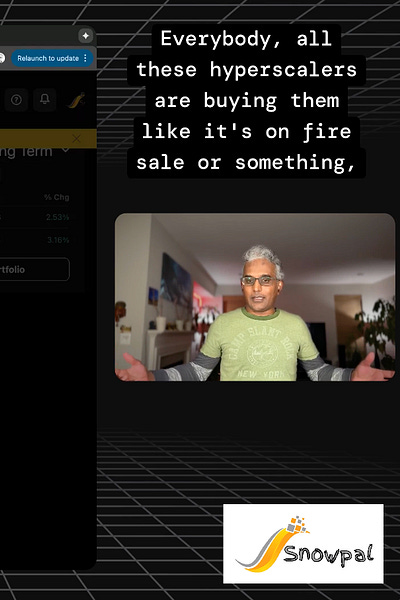The AI Cycle Wall Street Can’t Ignore
The AI ecosystem runs on a cyclical web of investments centered around NVIDIA, with companies like OpenAI, Microsoft, Oracle, AMD, and CoreWeave deeply interconnected.
In this conversation, Krish Palaniappan discusses the risks associated with investments in the current market, particularly focusing on the potential for solid investments to weaken and the implications this could have on the broader ecosystem. He raises concerns about the expectations of the investment community and explores the use of AI tools to predict possible market scenarios based on these risks.
Money flows in loops—NVIDIA funds companies that then buy NVIDIA GPUs—creating rapid growth but also heavy dependence. Recent volatility across major players shows how fragile this ecosystem is if any major link weakens.
Takeaways
There is a risk associated with investment expectations.
The stability of the ecosystem relies on solid investments.
Weakening investments can lead to market instability.
AI tools can help predict market scenarios.
Understanding the ripple effect is crucial for investors.
Investment community expectations can influence market behavior.
The relationship between investments can change unexpectedly.
Market predictions are essential for strategic planning.
Evaluating potential risks is key to investment success.
The implications of investment failures can be severe.
Podcast
Summary
1. Introduction: AI Everywhere
Krish opens by noting that AI dominates workplace conversations, media, and feeds.
Introduces the focus: the cyclical nature of AI investments and uses a Bloomberg illustration to explain it.
2. The Bloomberg Diagram: NVIDIA at the Center
Screen share of the diagram showing NVIDIA at the core of the AI investment ecosystem.
Their market cap is enormous relative to others—depicted by the huge central circle.
3. Key Players and Relationship Mapping
Krish walks through the companies and explains their links:
OpenAI → AMD: OpenAI to deploy 6GW of AMD GPUs; AMD grants options for 160M shares.
Oracle → NVIDIA: Oracle spends tens of billions on NVIDIA chips to power OCI.
OpenAI ↔ NVIDIA: NVIDIA invests $100B in OpenAI; OpenAI then spends $300B with Oracle, looping back to NVIDIA chip purchases.
Microsoft → OpenAI → NVIDIA: Microsoft’s stake and GPU consumption tie them into the cycle.
CoreWeave & Nebius: Smaller but fast-growing GPU cloud players built on NVIDIA hardware.
4. Why It’s Cyclical
Money flows in circles: NVIDIA funds companies → those companies buy NVIDIA GPUs → hyperscalers monetize or use them → strengthening NVIDIA’s position.
This reinforces demand, valuations, and capital allocation.
5. The Risk: What If One Link Breaks?
If any major arrow (investment/partnership) weakens or collapses, the entire network could destabilize.
Krish wonders what a “weak link” scenario would look like and what ripple effects would hit markets.
6. Case Study: Oracle’s 40% Crash
Oracle hit ~$345 after September earnings, then dropped to ~$200—over 40% down.
Example of volatility even among longtime stable tech giants.
7. Case Study: CoreWeave & Nebius Volatility
CoreWeave nearly doubled but also fell ~50% from its peak.
Nebius up 230% YTD but down ~33% in weeks.
Highlights how “GPU-infrastructure” companies experience extreme swings.
8. Even NVIDIA Isn’t Immune
NVIDIA fell from ~$210 to ~$182—~15% drop, which equals hundreds of billions in value.
Hyperscalers collectively may have lost $1–1.5T in a short span.
9. Macro Context: Trillion-Dollar Volatility
Companies like Microsoft, Google, AWS, Meta, Tesla, Broadcom—all multi-trillion dollar—are experiencing large fluctuations.
Illustrates how fragile market confidence can be even at this scale.
10. Final Thoughts & Call for Perspectives
Krish summarizes that the AI investment landscape is cyclical, interconnected, and fragile.
Invites discussion on potential weak links and plans to explore each company and its value proposition in future content.


